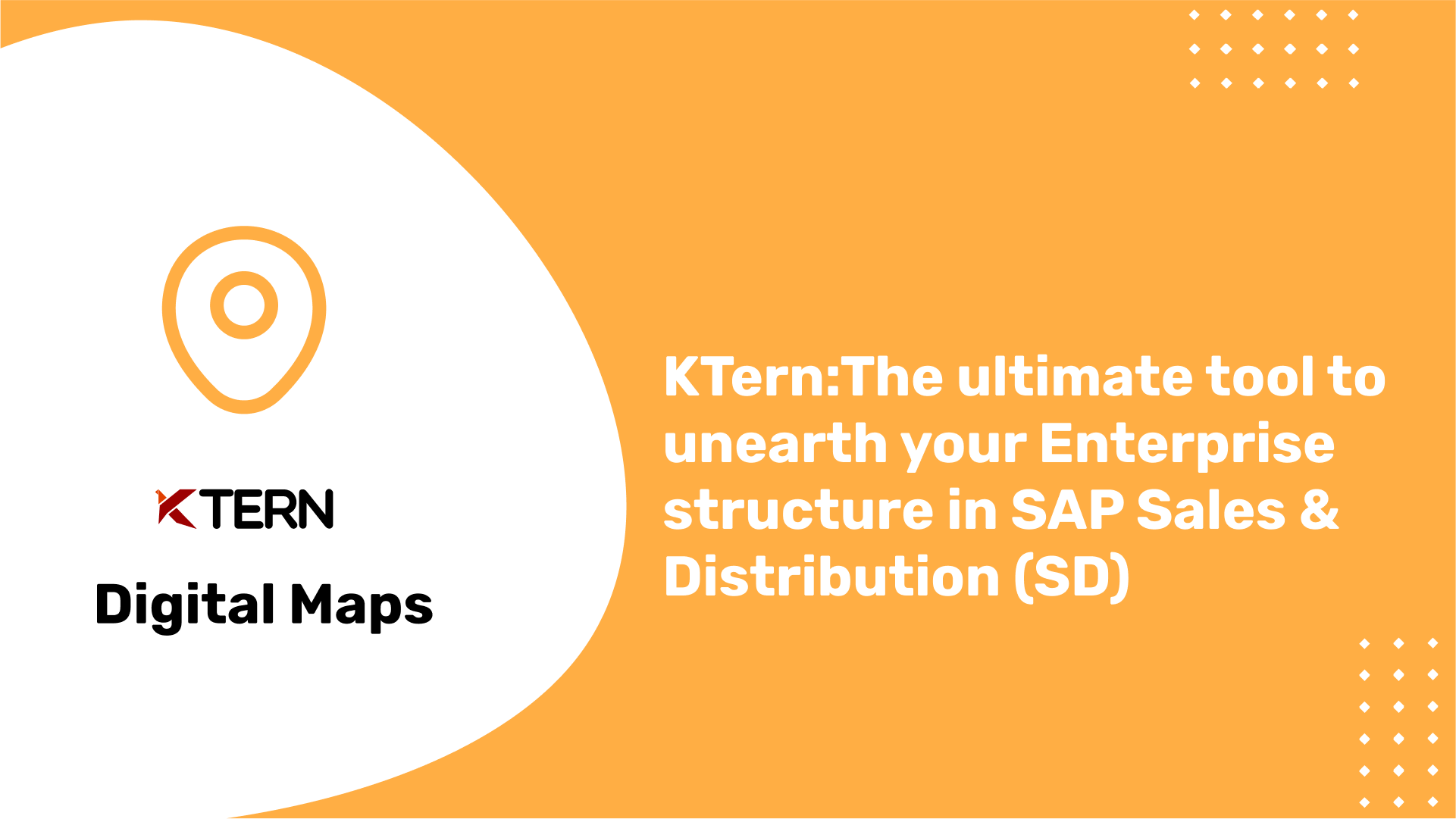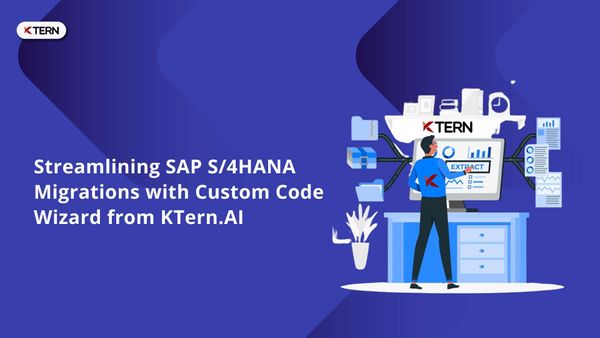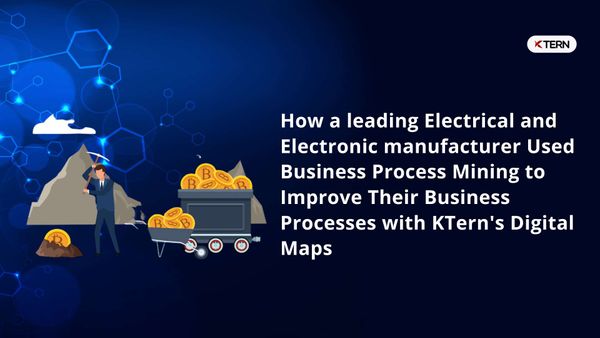KTern.AI:The ultimate tool to unearth your Enterprise structure in SAP Sales & Distribution (SD)
SAP S/4HANA is an intelligent ERP suite. SAP HANA and SAP Leonardo Platform power this next-gen ERP. S/4HANA impacts every nook and corner of your enterprise records and processes. With the deadline of 2025 approaching soon, the transition from SAP ECC to SAP S/4HANA for your enterprise is not going to be simple. One of the primary reasons for the complexity of any SAP S/4HANA transition project is the vast legacy data and the customizations that need to be migrated.

You may have customized your SAP ECC system over the past several decades to accommodate the business process of your organization. However, not all of these enterprise structures, enhancements and customizations may be useful. Some of them may have been developed several years back and might not be relevant to your business today. Such enterprise structures, processes and customizations can be left behind in ECC or can be archived. It only makes sense to take the relevant and most useful enterprise structures in SAP ECC to S/4HANA. This will not only ease the transition process but will also aid during the testing phase and in optimizing your business.
But for that, we have to first identify the relevant Enterprise Structures in SAP. Generally, organizations identify these relevant structures in the Discover phase of the Activate Methodology itself. In this article, we will explain how you can unearth your Organization’s Enterprise Sales structure automatically with the help of KTern.
Table of Contents:
- What is an Enterprise Structure in SAP SD?
- How can KTern help your Business by unearthing the Enterprise Structure?
- The Objective of Enterprise Structure Mining – Sales?
- Why is it important to unearth the Enterprise Structure?
- Features of Enterprise Structure Mining – Sales
- Advantages of Enterprise Structure Mining
- How is KTern’s Enterprise Structure Mining different from that of its competitors?
- Next Steps
What is an Enterprise Structure in SAP SD?
Each module in SAP has its own enterprise structure. An Enterprise Structure in SAP is nothing but the framework or structure according to which the whole business runs. And every organization has or at least should have some structure. There are several organizational units within an enterprise structure.
An enterprise structure in SAP clearly defines the numerous levels in an organization. Each level has a distinct functionality associated with it, and the levels are categorized according to some hierarchy. The levels, when combined, describe the working of an organization.
The Sales and Distribution module in SAP has the following organizational units:
- Sales Organization
- Distribution Channel
- Sales Office
- Division
- Sales Group
- Company Code (maintained by Finance module)
- Plant (maintained by MM module)
- Storage location (maintained by PM module)
- Sales Area

Company Code:
The Finance (FI) module creates and maintains the Company Code. It is the top organizational unit of Finance. In addition, the Company Code has a link to the Sales and Distribution (SD) module. Company Code is an independent legal entity. It creates and maintains the Balance Sheets and Profit and Loss Statements.
Sales Organization:
A Sales Organization is the highest level in the organizational structure of Sales and Distribution (SD). It is chiefly responsible for devising sales strategies, carrying out, and monitoring sales. All the sales reporting is done at the sales organization level only and all the documents are allocated to the sales organization.
Distribution Channel:
Distribution Channel refers to the process of distributing goods and services to the customers. It is the channel through which you can reach your customer or end consumer.
Division:
Division groups similar goods and services together. The grouping is based on certain traits or properties. The Sales and Distribution module should contain at least one division for execution. A Division contains the goods, materials and services which are sold to a customer. Example: Sales, Service and Spare Parts.
Plant:
Plant in an SAP system is a broad term and has varying definitions in different modules. In SAP Sales and Distribution (SD), a plant refers to a facility from where the finished product is distributed to the customer or end consumer.
Sales Area:
In SAP SD, a sales area is nothing but a combination of the sales organization, distribution channel and division. A particular sales organization can employ any strategy to reach its potential market via a distribution channel to sell a good or service belonging to a certain division.
Sales Office:
An organization may set up several sales offices apart from the head office to reach penetrate its target market. These offices are often located at different geographical locations. The performance of each geographical area can be analyzed with reporting at the sales office level. It acts as an intermediary office between the sales headquarters, sales department and the end customer.
Storage Location
A storage location maintains the stock. There are several types of storage location such as raw material storage location, finished goods storage location, return sales storage location, spares storage location, temperature-controlled storage location etc.
Sales Group:
Sales group refers to the employees in a sales office. A sales group is the subset of a sales office and you can assign them to their respective sales offices.
How can KTern help your Business by unearthing the Enterprise Structure?

So far, we have discussed only the Enterprise Structure in SAP Sales and Distribution (SD) module and its various organizational units. When you plan your move from SAP ECC to SAP S/4HANA, it is necessary to have a clear picture of your organization structure. This is a tedious task and involves a lot of manual effort. Now, we will discuss how KTern automates the process.
The Objective of Enterprise Structure Mining – Sales?
The main purpose of Enterprise Structure Mining before moving S/4HANA is to find out the relevant and useful company codes, sales organizations and the other organizational units. Most of these enterprise sales organization would have been modelled long back and the documentations might not be available today. There also might have been several changes since the document was last updated. And the ageing workforce of SAP does not make the situation any better.
It is necessary to give proper training and handover to the millennial workforce. However, with the disparate information and inconsistent documentation, it is not always possible. KTern can help you here by continuous monitoring and providing materiality of where the consultants should focus. Mostly this information or knowledge is with a privileged few or in the System Integrator's privy.
KTern helps you to unearth the sales model and provide the information ina easy-to-consume format.
The findings from this tool, KTern, will help you determine the most useful/most used organizational units. Therefore, business stakeholders will have better clarity and make data-driven decisions with confidence.
Why is it important to unearth the Enterprise Structure?
Typically, in most S/4HANA assessments, as the first step, organizations aim to find out the enterprise structure in SAP and drill down the hierarchy of each functional module. They find out answers to questions like - What is the type of the system? What is the orientation of the SAP system? How and who uses the system? What is the most effectively used process? How many company codes are there in the system? What are the most effectively used sales organizations? And much more.
Finding out answers to these questions is a very manual task. Many functional consultants are deployed for this purpose. The functional consultants then go through each T-Code, Table and Report to map the hierarchy of the enterprise structure in SAP and find out the complexity of the system. Sounds tiring, right? But this step is mandatory and cannot be skipped. Only after this step, you can proceed with the next step in the system conversion process.
KTern's Enterprise Structure Mining
With KTern, you can automate and find out the entire enterprise structure in SAP with just the click of a button. You can find the answers to the above crucial questions easily. This feature is in the Discover phase of the Activate Methodology and is covered in the Impact Analysis module of KTern.
Features of Enterprise Structure Mining – Sales

As seen in the above picture, KTern’s Enterprise Structure Mining feature drills down the various organizational units. It drills down from company codes, sales organizations, distribution channels, plants and all the way up to the sales documents generated. In this way, KTern provides a clear hierarchy and evidently maps the organizational structure.
The hierarchy of a sales organization is as follows:
Company Code -> Sales Organization -> Distribution Channel -> Division -> Plant -> Number of Sales Documents Generated
- The functional consultants manually doing this task will definitely not be able to provide such clarity and accuracy in mapping the org structure.
- They have to go through each table, record and t-code to get this information.
- And even then, they will not be able to get the total picture. And, let’s not talk about the time required to complete the task.
- It may take several weeks or even months to complete it.
- KTern automates the task and provides the results in a span of few minutes.
Advantages of Enterprise Structure Mining

Sort and Search
An important feature of KTern’s Enterprise Structure Mining is that you can sort and search the company codes, purchasing organizations, purchasing groups, plant, storage location, and the number of purchase documents.
This enables you to determine the most active company codes, purchasing organizations and so on.
Example:
If only two purchase documents are generated for the past 5 years in one of the plants, then it can be inferred that that particular plant is not active. After taking a call with the business stakeholders, you need not move that particular plant to S/4HANA.
KTern's Observations helps the MM functional consultants, business stakeholders from both the System Integrator side and the customer side, and the Solution Architects to have a clear picture of the landscape and take better data-driven decisions.
Collaboration
KTern also provides the option of downloading this report. In addition, you can also post it in the forum, assign stakeholders and collaborate. You can upload the files in KTern and subsequently use it any other stage of the system conversion process. Thus, KTern provides a platform to join forces and work together in determining the relevant enterprise structures in SAP and plan the path to S/4HANA.
Pre-Go-Live Check
One more important use case of this feature is that you that perform a pre-Go-Live check in a greenfield implementation. In a greenfield implementation, the customer usually provides the configuration requirement. The System Integrator then maps the enterprise structure according to the configuration and tests them accordingly. Enterprise Structure Mining feature of KTern can be used to audit the configured landscape. This allows the customer to Go-Live with the system without any apprehensions.
How is KTern’s Enterprise Structure Mining different from that of its competitors?
Most of the organizations today do this task of mapping the enterprise structure in SAP manually. More often than not, they rely upon the consultants and business stakeholders to provide the right information. The reliability of such information can only be left to anyone’s imagination. However, there are few products in the market which aim to automate the process of Enterprise Structure mining. SNP and Celonis are some examples. However, they also do not go into the level of detail that KTern.AI does. KTern.AI provides both a visual and tabular representation of the enterprise structure in SAP which makes it easier to have clarity and make decisions.

KTern.AI also provides additional insights such as the percentage of each module usage, the most used company codes, the least used company codes, the plant with most and least sales documents etc. All the above insights combined with the productivity and collaboration features make KTern a leader in the market when it comes to SAP Digital Transformations.
Next Steps
Now that you know how to automate the Enterprise Structure Mining using KTern, you might want to get a first-hand feel of KTern and its other features which help automate and govern SAP projects from start to finish. You can get started with the same at Getting Started. Alternatively, if you would like a guided demo of the product from one of our product engineers, kindly get in touch with us by submitting a message at Contact Us.
If you need more validation, have a look at our articles repository!




